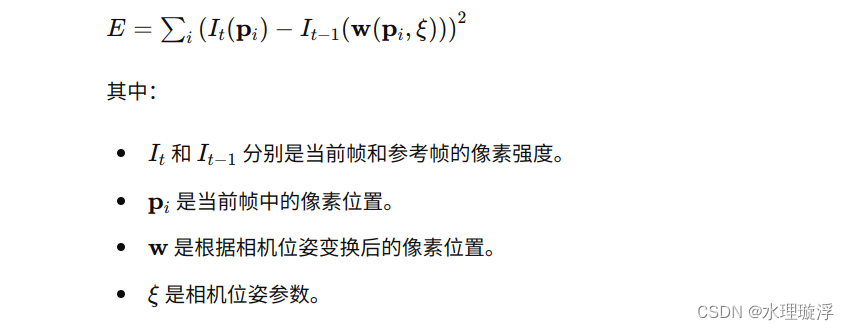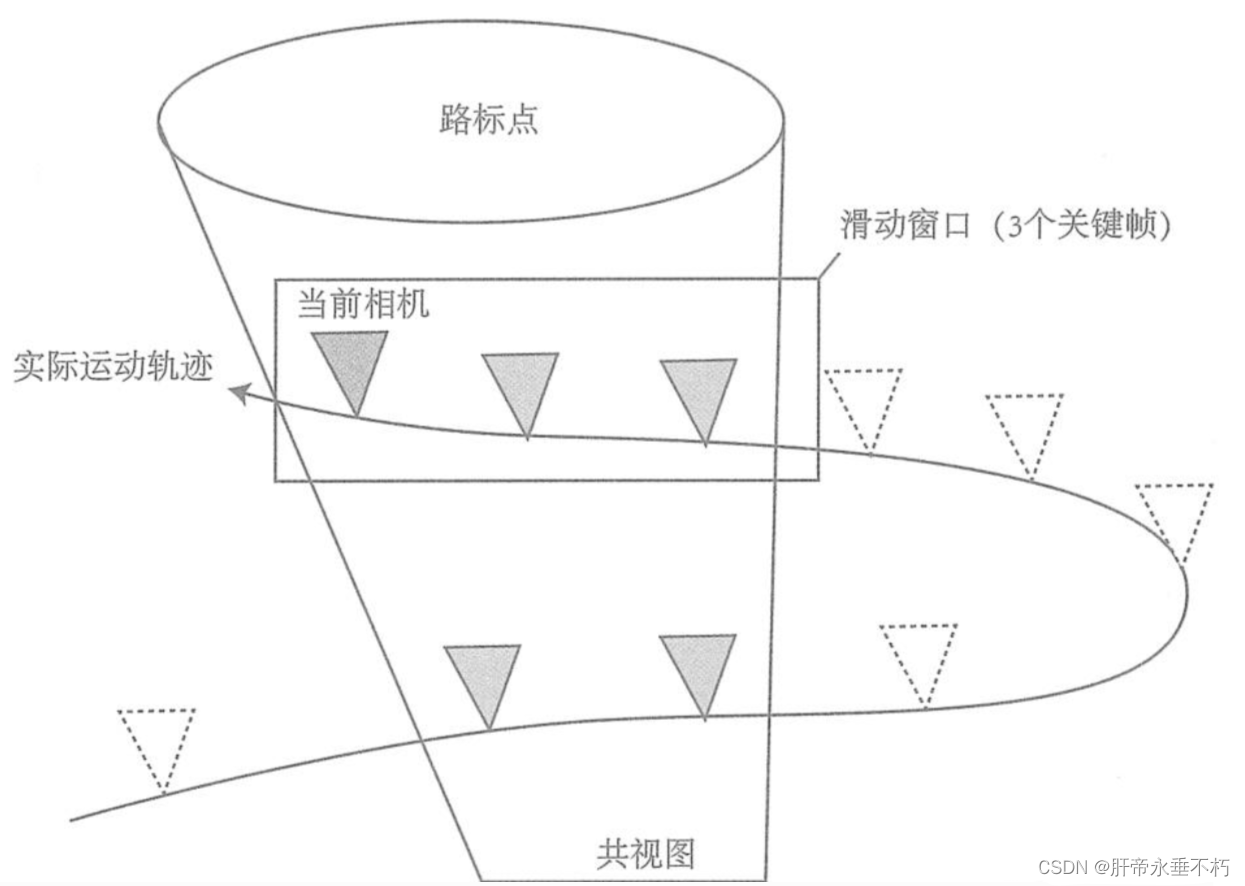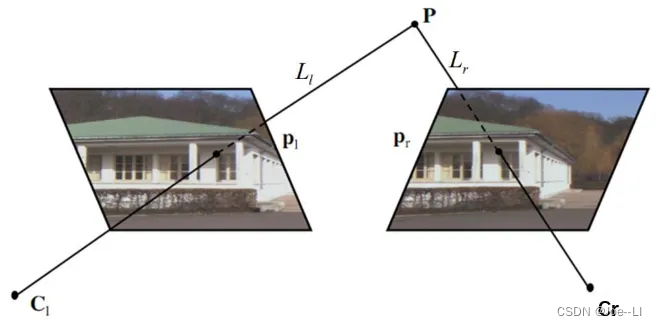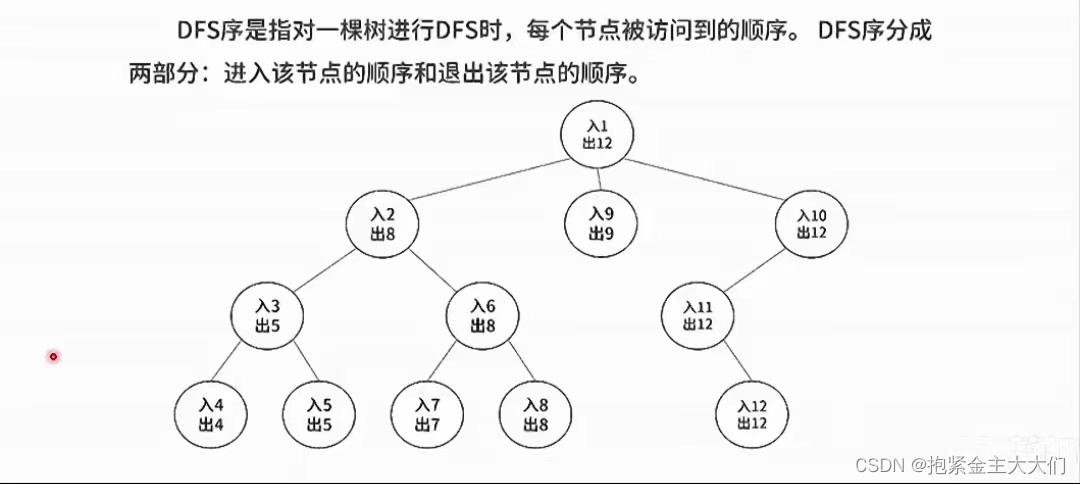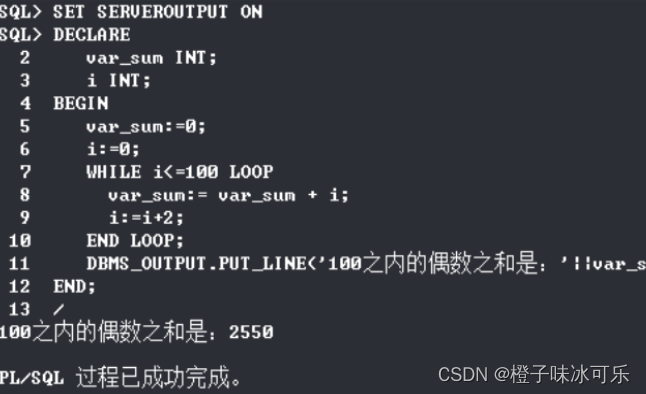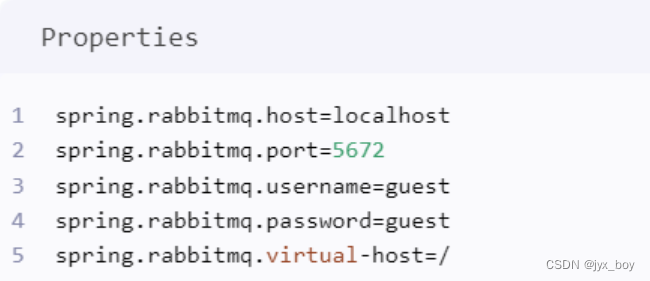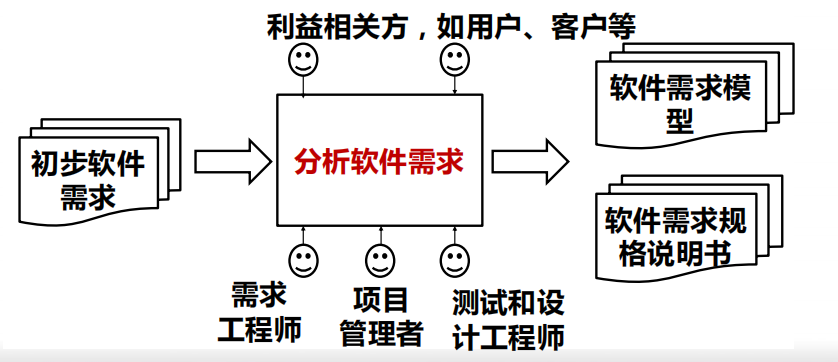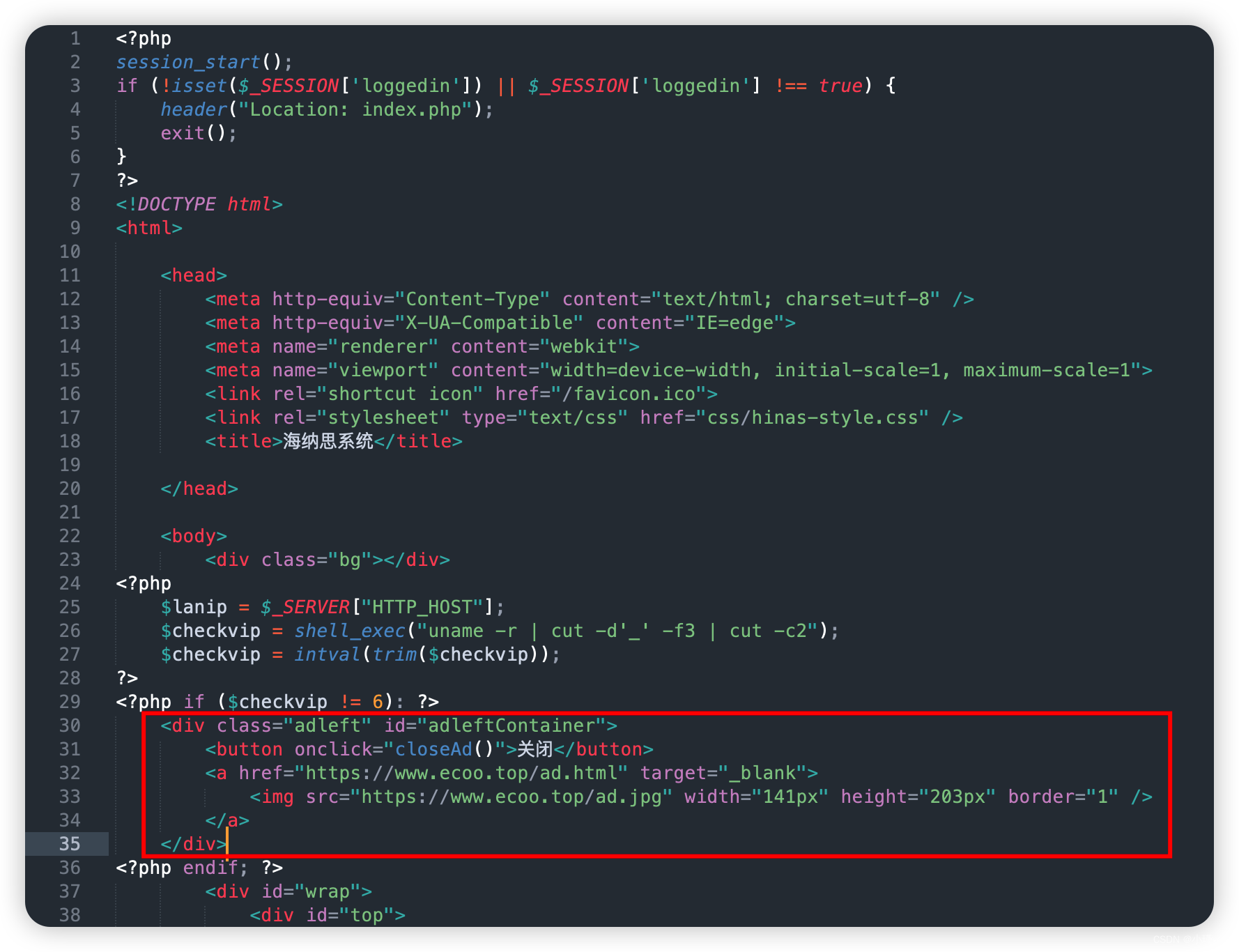视觉SLAM学习打卡【7-2】-视觉里程计·特征点法程序详解
1.opencv特征提取和匹配 orb_cv.cpp
该blog写的较为详细:点击跳转
2.手写ORB特征 orb_self.cpp
#include <opencv2/opencv.hpp>
#include <string>
#include <nmmintrin.h>
#include <chrono>
using namespace std;
string first_file = "./1.png";
string second_file = "./2.png";
typedef vector<uint32_t> DescType;
void ComputeORB(const cv::Mat &img, vector<cv::KeyPoint> &keypoints, vector<DescType> &descriptors);
void BfMatch(const vector<DescType> &desc1, const vector<DescType> &desc2, vector<cv::DMatch> &matches);
int main(int argc, char **argv) {
cv::Mat first_image = cv::imread(first_file, 0);
cv::Mat second_image = cv::imread(second_file, 0);
assert(first_image.data != nullptr && second_image.data != nullptr);
chrono::steady_clock::time_point t1 = chrono::steady_clock::now();
vector<cv::KeyPoint> keypoints1;
cv::FAST(first_image, keypoints1, 40);
vector<DescType> descriptor1;
ComputeORB(first_image, keypoints1, descriptor1);
vector<cv::KeyPoint> keypoints2;
vector<DescType> descriptor2;
cv::FAST(second_image, keypoints2, 40);
ComputeORB(second_image, keypoints2, descriptor2);
chrono::steady_clock::time_point t2 = chrono::steady_clock::now();
chrono::duration<double> time_used = chrono::duration_cast<chrono::duration<double>>(t2 - t1);
cout << "extract ORB cost = " << time_used.count() << " seconds. " << endl;
vector<cv::DMatch> matches;
t1 = chrono::steady_clock::now();
BfMatch(descriptor1, descriptor2, matches);
t2 = chrono::steady_clock::now();
time_used = chrono::duration_cast<chrono::duration<double>>(t2 - t1);
cout << "match ORB cost = " << time_used.count() << " seconds. " << endl;
cout << "matches: " << matches.size() << endl;
cv::Mat image_show;
cv::drawMatches(first_image, keypoints1, second_image, keypoints2, matches, image_show);
cv::imshow("matches", image_show);
cv::imwrite("matches.png", image_show);
cv::waitKey(0);
cout << "done." << endl;
return 0;
}
#pragma region ORB_pattern[256 * 4]相当于在以关键点为中心[-13,12]的范围内,随机选点对p,q;进行关键点的向量构建
int ORB_pattern[256 * 4] = {
8, -3, 9, 5,
4, 2, 7, -12,
-11, 9, -8, 2,
7, -12, 12, -13,
2, -13, 2, 12,
1, -7, 1, 6,
-2, -10, -2, -4,
-13, -13, -11, -8,
-13, -3, -12, -9,
10, 4, 11, 9,
-13, -8, -8, -9,
-11, 7, -9, 12,
7, 7, 12, 6,
-4, -5, -3, 0,
-13, 2, -12, -3,
-9, 0, -7, 5,
12, -6, 12, -1,
-3, 6, -2, 12,
-6, -13, -4, -8,
11, -13, 12, -8,
4, 7, 5, 1,
5, -3, 10, -3,
3, -7, 6, 12,
-8, -7, -6, -2,
-2, 11, -1, -10,
-13, 12, -8, 10,
-7, 3, -5, -3,
-4, 2, -3, 7,
-10, -12, -6, 11,
5, -12, 6, -7,
5, -6, 7, -1,
1, 0, 4, -5,
9, 11, 11, -13,
4, 7, 4, 12,
2, -1, 4, 4,
-4, -12, -2, 7,
-8, -5, -7, -10,
4, 11, 9, 12,
0, -8, 1, -13,
-13, -2, -8, 2,
-3, -2, -2, 3,
-6, 9, -4, -9,
8, 12, 10, 7,
0, 9, 1, 3,
7, -5, 11, -10,
-13, -6, -11, 0,
10, 7, 12, 1,
-6, -3, -6, 12,
10, -9, 12, -4,
-13, 8, -8, -12,
-13, 0, -8, -4,
3, 3, 7, 8,
5, 7, 10, -7,
-1, 7, 1, -12,
3, -10, 5, 6,
2, -4, 3, -10,
-13, 0, -13, 5,
-13, -7, -12, 12,
-13, 3, -11, 8,
-7, 12, -4, 7,
6, -10, 12, 8,
-9, -1, -7, -6,
-2, -5, 0, 12,
-12, 5, -7, 5,
3, -10, 8, -13,
-7, -7, -4, 5,
-3, -2, -1, -7,
2, 9, 5, -11,
-11, -13, -5, -13,
-1, 6, 0, -1,
5, -3, 5, 2,
-4, -13, -4, 12,
-9, -6, -9, 6,
-12, -10, -8, -4,
10, 2, 12, -3,
7, 12, 12, 12,
-7, -13, -6, 5,
-4, 9, -3, 4,
7, -1, 12, 2,
-7, 6, -5, 1,
-13, 11, -12, 5,
-3, 7, -2, -6,
7, -8, 12, -7,
-13, -7, -11, -12,
1, -3, 12, 12,
2, -6, 3, 0,
-4, 3, -2, -13,
-1, -13, 1, 9,
7, 1, 8, -6,
1, -1, 3, 12,
9, 1, 12, 6,
-1, -9, -1, 3,
-13, -13, -10, 5,
7, 7, 10, 12,
12, -5, 12, 9,
6, 3, 7, 11,
5, -13, 6, 10,
2, -12, 2, 3,
3, 8, 4, -6,
2, 6, 12, -13,
9, -12, 10, 3,
-8, 4, -7, 9,
-11, 12, -4, -6,
1, 12, 2, -8,
6, -9, 7, -4,
2, 3, 3, -2,
6, 3, 11, 0,
3, -3, 8, -8,
7, 8, 9, 3,
-11, -5, -6, -4,
-10, 11, -5, 10,
-5, -8, -3, 12,
-10, 5, -9, 0,
8, -1, 12, -6,
4, -6, 6, -11,
-10, 12, -8, 7,
4, -2, 6, 7,
-2, 0, -2, 12,
-5, -8, -5, 2,
7, -6, 10, 12,
-9, -13, -8, -8,
-5, -13, -5, -2,
8, -8, 9, -13,
-9, -11, -9, 0,
1, -8, 1, -2,
7, -4, 9, 1,
-2, 1, -1, -4,
11, -6, 12, -11,
-12, -9, -6, 4,
3, 7, 7, 12,
5, 5, 10, 8,
0, -4, 2, 8,
-9, 12, -5, -13,
0, 7, 2, 12,
-1, 2, 1, 7,
5, 11, 7, -9,
3, 5, 6, -8,
-13, -4, -8, 9,
-5, 9, -3, -3,
-4, -7, -3, -12,
6, 5, 8, 0,
-7, 6, -6, 12,
-13, 6, -5, -2,
1, -10, 3, 10,
4, 1, 8, -4,
-2, -2, 2, -13,
2, -12, 12, 12,
-2, -13, 0, -6,
4, 1, 9, 3,
-6, -10, -3, -5,
-3, -13, -1, 1,
7, 5, 12, -11,
4, -2, 5, -7,
-13, 9, -9, -5,
7, 1, 8, 6,
7, -8, 7, 6,
-7, -4, -7, 1,
-8, 11, -7, -8,
-13, 6, -12, -8,
2, 4, 3, 9,
10, -5, 12, 3,
-6, -5, -6, 7,
8, -3, 9, -8,
2, -12, 2, 8,
-11, -2, -10, 3,
-12, -13, -7, -9,
-11, 0, -10, -5,
5, -3, 11, 8,
-2, -13, -1, 12,
-1, -8, 0, 9,
-13, -11, -12, -5,
-10, -2, -10, 11,
-3, 9, -2, -13,
2, -3, 3, 2,
-9, -13, -4, 0,
-4, 6, -3, -10,
-4, 12, -2, -7,
-6, -11, -4, 9,
6, -3, 6, 11,
-13, 11, -5, 5,
11, 11, 12, 6,
7, -5, 12, -2,
-1, 12, 0, 7,
-4, -8, -3, -2,
-7, 1, -6, 7,
-13, -12, -8, -13,
-7, -2, -6, -8,
-8, 5, -6, -9,
-5, -1, -4, 5,
-13, 7, -8, 10,
1, 5, 5, -13,
1, 0, 10, -13,
9, 12, 10, -1,
5, -8, 10, -9,
-1, 11, 1, -13,
-9, -3, -6, 2,
-1, -10, 1, 12,
-13, 1, -8, -10,
8, -11, 10, -6,
2, -13, 3, -6,
7, -13, 12, -9,
-10, -10, -5, -7,
-10, -8, -8, -13,
4, -6, 8, 5,
3, 12, 8, -13,
-4, 2, -3, -3,
5, -13, 10, -12,
4, -13, 5, -1,
-9, 9, -4, 3,
0, 3, 3, -9,
-12, 1, -6, 1,
3, 2, 4, -8,
-10, -10, -10, 9,
8, -13, 12, 12,
-8, -12, -6, -5,
2, 2, 3, 7,
10, 6, 11, -8,
6, 8, 8, -12,
-7, 10, -6, 5,
-3, -9, -3, 9,
-1, -13, -1, 5,
-3, -7, -3, 4,
-8, -2, -8, 3,
4, 2, 12, 12,
2, -5, 3, 11,
6, -9, 11, -13,
3, -1, 7, 12,
11, -1, 12, 4,
-3, 0, -3, 6,
4, -11, 4, 12,
2, -4, 2, 1,
-10, -6, -8, 1,
-13, 7, -11, 1,
-13, 12, -11, -13,
6, 0, 11, -13,
0, -1, 1, 4,
-13, 3, -9, -2,
-9, 8, -6, -3,
-13, -6, -8, -2,
5, -9, 8, 10,
2, 7, 3, -9,
-1, -6, -1, -1,
9, 5, 11, -2,
11, -3, 12, -8,
3, 0, 3, 5,
-1, 4, 0, 10,
3, -6, 4, 5,
-13, 0, -10, 5,
5, 8, 12, 11,
8, 9, 9, -6,
7, -4, 8, -12,
-10, 4, -10, 9,
7, 3, 12, 4,
9, -7, 10, -2,
7, 0, 12, -2,
-1, -6, 0, -11
};
#pragma endregion
void ComputeORB(const cv::Mat &img, vector<cv::KeyPoint> &keypoints, vector<DescType> &descriptors) {
const int half_patch_size = 8;
const int half_boundary = 16;
int bad_points = 0;
for (auto &kp: keypoints) {
if (kp.pt.x < half_boundary || kp.pt.y < half_boundary ||
kp.pt.x >= img.cols - half_boundary || kp.pt.y >= img.rows - half_boundary) {
bad_points++;
descriptors.push_back({});
continue;
}
float m01 = 0, m10 = 0;
for (int dx = -half_patch_size; dx < half_patch_size; ++dx)
{
for (int dy = -half_patch_size; dy < half_patch_size; ++dy)
{
uchar pixel = img.at<uchar>(kp.pt.y + dy, kp.pt.x + dx);
m01 += dx * pixel;
m10 += dy * pixel;
}
}
float m_sqrt = sqrt(m01 * m01 + m10 * m10) + 1e-18;
float sin_theta = m01 / m_sqrt;
float cos_theta = m10 / m_sqrt;
DescType desc(8, 0);
for (int i = 0; i < 8; i++) {
uint32_t d = 0;
for (int k = 0; k < 32; k++) {
int idx_pq = i * 8 + k;
cv::Point2f p(ORB_pattern[idx_pq * 4], ORB_pattern[idx_pq * 4 + 1]);
cv::Point2f q(ORB_pattern[idx_pq * 4 + 2], ORB_pattern[idx_pq * 4 + 3]);
cv::Point2f pp = cv::Point2f(cos_theta * p.x - sin_theta * p.y, sin_theta * p.x + cos_theta * p.y)
+ kp.pt;
cv::Point2f qq = cv::Point2f(cos_theta * q.x - sin_theta * q.y, sin_theta * q.x + cos_theta * q.y)
+ kp.pt;
if (img.at<uchar>(pp.y, pp.x) < img.at<uchar>(qq.y, qq.x)) {
d |= 1 << k;
}
}
desc[i] = d;
}
descriptors.push_back(desc);
}
cout << "bad/total: " << bad_points << "/" << keypoints.size() << endl;
}
void BfMatch(const vector<DescType> &desc1, const vector<DescType> &desc2, vector<cv::DMatch> &matches) {
const int d_max = 40;
for (size_t i1 = 0; i1 < desc1.size(); ++i1) {
if (desc1[i1].empty()) continue;
cv::DMatch m{i1, 0, 256};
for (size_t i2 = 0; i2 < desc2.size(); ++i2) {
if (desc2[i2].empty()) continue;
int distance = 0;
for (int k = 0; k < 8; k++) {
distance += _mm_popcnt_u32(desc1[i1][k] ^ desc2[i2][k]);
}
if (distance < d_max && distance < m.distance) {
m.distance = distance;
m.trainIdx = i2;
}
}
if (m.distance < d_max) {
matches.push_back(m);
}
}
}
3.对极约束求解相机运动 pose_estimation_2d2d.cpp
#include <iostream>
#include <opencv2/core/core.hpp>
#include <opencv2/features2d/features2d.hpp>
#include <opencv2/highgui/highgui.hpp>
#include <opencv2/calib3d/calib3d.hpp>
#include<chrono>
using namespace std;
using namespace cv;
void find_feature_matches(
const Mat &img_1, const Mat &img_2,
std::vector<KeyPoint> &keypoints_1,
std::vector<KeyPoint> &keypoints_2,
std::vector<DMatch> &matches);
void pose_estimation_2d2d(
std::vector<KeyPoint> keypoints_1,
std::vector<KeyPoint> keypoints_2,
std::vector<DMatch> matches,
Mat &R, Mat &t);
Point2d pixel2cam(const Point2d &p, const Mat &K);
int main(int argc, char **argv) {
chrono::steady_clock::time_point t1=chrono::steady_clock::now();
Mat img_1 = imread("/home/rxz/slambook2/ch7/1.png", CV_LOAD_IMAGE_COLOR);
Mat img_2 = imread("/home/rxz/slambook2/ch7/2.png", CV_LOAD_IMAGE_COLOR);
assert(img_1.data && img_2.data && "Can not load images!");
vector<KeyPoint> keypoints_1, keypoints_2;
vector<DMatch> matches;
find_feature_matches(img_1, img_2, keypoints_1, keypoints_2, matches);
cout << "一共找到了" << matches.size() << "组匹配点" << endl;
Mat R, t;
pose_estimation_2d2d(keypoints_1, keypoints_2, matches, R, t);
Mat t_x =
(Mat_<double>(3, 3) << 0, -t.at<double>(2, 0), t.at<double>(1, 0),
t.at<double>(2, 0), 0, -t.at<double>(0, 0),
-t.at<double>(1, 0), t.at<double>(0, 0), 0);
cout << "t^R=" << endl << t_x * R << endl;
Mat K = (Mat_<double>(3, 3) << 520.9, 0, 325.1, 0, 521.0, 249.7, 0, 0, 1);
for (DMatch m: matches) {
Point2d pt1 = pixel2cam(keypoints_1[m.queryIdx].pt, K);
Mat y1 = (Mat_<double>(3, 1) << pt1.x, pt1.y, 1);
Point2d pt2 = pixel2cam(keypoints_2[m.trainIdx].pt, K);
Mat y2 = (Mat_<double>(3, 1) << pt2.x, pt2.y, 1);
Mat d = y2.t() * t_x * R * y1;
cout << "匹配点对的对极几何残差(epipolar constraint) = " << d << endl;
}
chrono::steady_clock::time_point t2=chrono::steady_clock::now();
chrono::duration<double>time_used=chrono::duration_cast<chrono::duration<double>>(t2-t1);
cout<<"程序所用时间:"<<time_used.count()<<"秒"<<endl;
return 0;
}
void find_feature_matches(const Mat &img_1, const Mat &img_2,
std::vector<KeyPoint> &keypoints_1,
std::vector<KeyPoint> &keypoints_2,
std::vector<DMatch> &matches) {
Mat descriptors_1, descriptors_2;
Ptr<FeatureDetector> detector = ORB::create();
Ptr<DescriptorExtractor> descriptor = ORB::create();
Ptr<DescriptorMatcher> matcher = DescriptorMatcher::create("BruteForce-Hamming");
detector->detect(img_1, keypoints_1);
detector->detect(img_2, keypoints_2);
descriptor->compute(img_1, keypoints_1, descriptors_1);
descriptor->compute(img_2, keypoints_2, descriptors_2);
vector<DMatch> match;
matcher->match(descriptors_1, descriptors_2, match);
double min_dist = 100, max_dist = 0;
for (int i = 0; i < descriptors_1.rows; i++) {
double dist = match[i].distance;
if (dist < min_dist) min_dist = dist;
if (dist > max_dist) max_dist = dist;
}
printf("-- Max dist : %f \n", max_dist);
printf("-- Min dist : %f \n", min_dist);
for (int i = 0; i < descriptors_1.rows; i++) {
if (match[i].distance <= max(2 * min_dist, 30.0)) {
matches.push_back(match[i]);
}
}
}
Point2d pixel2cam(const Point2d &p, const Mat &K) {
return Point2d
(
(p.x - K.at<double>(0, 2)) / K.at<double>(0, 0),
(p.y - K.at<double>(1, 2)) / K.at<double>(1, 1)
);
}
void pose_estimation_2d2d(std::vector<KeyPoint> keypoints_1,
std::vector<KeyPoint> keypoints_2,
std::vector<DMatch> matches,
Mat &R, Mat &t) {
Mat K = (Mat_<double>(3, 3) << 520.9, 0, 325.1, 0, 521.0, 249.7, 0, 0, 1);
vector<Point2f> points1;
vector<Point2f> points2;
for (int i = 0; i < (int) matches.size(); i++) {
points1.push_back(keypoints_1[matches[i].queryIdx].pt);
points2.push_back(keypoints_2[matches[i].trainIdx].pt);
}
Mat fundamental_matrix;
fundamental_matrix = findFundamentalMat(points1, points2, CV_FM_8POINT);
cout << "fundamental_matrix is " << endl << fundamental_matrix << endl;
Point2d principal_point(325.1, 249.7);
double focal_length = 521;
Mat essential_matrix;
essential_matrix = findEssentialMat(points1, points2, focal_length, principal_point);
cout << "essential_matrix is " << endl << essential_matrix << endl;
Mat homography_matrix;
homography_matrix = findHomography(points1, points2, RANSAC, 3);
cout << "homography_matrix is " << endl << homography_matrix << endl;
recoverPose(essential_matrix, points1, points2, R, t, focal_length, principal_point);
cout << "R is " << endl << R << endl;
cout << "t is " << endl << t << endl;
}
4.三角测量 triangulation.cpp
#include <iostream>
#include <opencv2/opencv.hpp>
#include<chrono>
using namespace std;
using namespace cv;
void find_feature_matches(
const Mat &img_1, const Mat &img_2,
std::vector<KeyPoint> &keypoints_1,
std::vector<KeyPoint> &keypoints_2,
std::vector<DMatch> &matches);
void pose_estimation_2d2d(
const std::vector<KeyPoint> &keypoints_1,
const std::vector<KeyPoint> &keypoints_2,
const std::vector<DMatch> &matches,
Mat &R, Mat &t);
void triangulation(
const vector<KeyPoint> &keypoint_1,
const vector<KeyPoint> &keypoint_2,
const std::vector<DMatch> &matches,
const Mat &R, const Mat &t,
vector<Point3d> &points
);
inline cv::Scalar get_color(float depth) {
float up_th = 50, low_th = 10, th_range = up_th - low_th;
if (depth > up_th) depth = up_th;
if (depth < low_th) depth = low_th;
return cv::Scalar(255 * depth / th_range, 0, 255 * (1 - depth / th_range));
}
Point2f pixel2cam(const Point2d &p, const Mat &K);
int main(int argc, char **argv) {
if (argc != 3) {
cout << "usage: triangulation img1 img2" << endl;
return 1;
}
chrono::steady_clock::time_point t1=chrono::steady_clock::now();
Mat img_1 = imread(argv[1], CV_LOAD_IMAGE_COLOR);
Mat img_2 = imread(argv[2], CV_LOAD_IMAGE_COLOR);
vector<KeyPoint> keypoints_1, keypoints_2;
vector<DMatch> matches;
find_feature_matches(img_1, img_2, keypoints_1, keypoints_2, matches);
cout << "一共找到了" << matches.size() << "组匹配点" << endl;
Mat R, t;
pose_estimation_2d2d(keypoints_1, keypoints_2, matches, R, t);
vector<Point3d> points;
triangulation(keypoints_1, keypoints_2, matches, R, t, points);
Mat K = (Mat_<double>(3, 3) << 520.9, 0, 325.1, 0, 521.0, 249.7, 0, 0, 1);
Mat img1_plot = img_1.clone();
Mat img2_plot = img_2.clone();
for (int i = 0; i < matches.size(); i++) {
float depth1 = points[i].z;
cout <<"第"<<i<<"个匹配点的depth: "<< depth1 << endl;
Point2d pt1_cam = pixel2cam(keypoints_1[matches[i].queryIdx].pt, K);
cv::circle(img1_plot, keypoints_1[matches[i].queryIdx].pt, 2, get_color(depth1), 2,8,0);
Mat pt2_trans = R * (Mat_<double>(3, 1) << points[i].x, points[i].y, points[i].z) + t;
float depth2 = pt2_trans.at<double>(2, 0);
cv::circle(img2_plot, keypoints_2[matches[i].trainIdx].pt, 2, get_color(depth2), 2);
}
cv::imshow("img 1", img1_plot);
cv::imshow("img 2", img2_plot);
chrono::steady_clock::time_point t2=chrono::steady_clock::now();
chrono::duration<double>time_used=chrono::duration_cast<chrono::duration<double>>(t2-t1);
cout<<"time spent by project: "<<time_used.count()<<"second"<<endl;
cv::waitKey();
return 0;
}
void find_feature_matches(const Mat &img_1, const Mat &img_2,
std::vector<KeyPoint> &keypoints_1,
std::vector<KeyPoint> &keypoints_2,
std::vector<DMatch> &matches) {
Mat descriptors_1, descriptors_2;
Ptr<FeatureDetector> detector = ORB::create();
Ptr<DescriptorExtractor> descriptor = ORB::create();
Ptr<DescriptorMatcher> matcher = DescriptorMatcher::create("BruteForce-Hamming");
detector->detect(img_1, keypoints_1);
detector->detect(img_2, keypoints_2);
descriptor->compute(img_1, keypoints_1, descriptors_1);
descriptor->compute(img_2, keypoints_2, descriptors_2);
vector<DMatch> match;
matcher->match(descriptors_1, descriptors_2, match);
double min_dist = 10000, max_dist = 0;
for (int i = 0; i < descriptors_1.rows; i++) {
double dist = match[i].distance;
if (dist < min_dist) min_dist = dist;
if (dist > max_dist) max_dist = dist;
}
printf("-- Max dist : %f \n", max_dist);
printf("-- Min dist : %f \n", min_dist);
for (int i = 0; i < descriptors_1.rows; i++) {
if (match[i].distance <= max(2 * min_dist, 30.0)) {
matches.push_back(match[i]);
}
}
}
void pose_estimation_2d2d(
const std::vector<KeyPoint> &keypoints_1,
const std::vector<KeyPoint> &keypoints_2,
const std::vector<DMatch> &matches,
Mat &R, Mat &t) {
Mat K = (Mat_<double>(3, 3) << 520.9, 0, 325.1, 0, 521.0, 249.7, 0, 0, 1);
vector<Point2f> points1;
vector<Point2f> points2;
for (int i = 0; i < (int) matches.size(); i++) {
points1.push_back(keypoints_1[matches[i].queryIdx].pt);
points2.push_back(keypoints_2[matches[i].trainIdx].pt);
}
Point2d principal_point(325.1, 249.7);
int focal_length = 521;
Mat essential_matrix;
essential_matrix = findEssentialMat(points1, points2, focal_length, principal_point);
recoverPose(essential_matrix, points1, points2, R, t, focal_length, principal_point);
cout<<"R 矩阵:"<<endl<< R <<endl;
}
void triangulation(
const vector<KeyPoint> &keypoint_1,
const vector<KeyPoint> &keypoint_2,
const std::vector<DMatch> &matches,
const Mat &R, const Mat &t,
vector<Point3d> &points) {
Mat T1 = (Mat_<float>(3, 4) <<
1, 0, 0, 0,
0, 1, 0, 0,
0, 0, 1, 0);
Mat T2 = (Mat_<float>(3, 4) <<
R.at<double>(0, 0), R.at<double>(0, 1), R.at<double>(0, 2), t.at<double>(0, 0),
R.at<double>(1, 0), R.at<double>(1, 1), R.at<double>(1, 2), t.at<double>(1, 0),
R.at<double>(2, 0), R.at<double>(2, 1), R.at<double>(2, 2), t.at<double>(2, 0)
);
Mat K = (Mat_<double>(3, 3) << 520.9, 0, 325.1, 0, 521.0, 249.7, 0, 0, 1);
vector<Point2f> pts_1, pts_2;
for(int i=0;i<matches.size();i++)
{
DMatch m=matches[i];
pts_1.push_back(pixel2cam(keypoint_1[m.queryIdx].pt, K));
pts_2.push_back(pixel2cam(keypoint_2[m.trainIdx].pt, K));
}
Mat pts_4d;
cv::triangulatePoints(T1, T2, pts_1, pts_2, pts_4d);
for (int i = 0; i < pts_4d.cols; i++) {
Mat x = pts_4d.col(i);
x /= x.at<float>(3, 0);
Point3d p(
x.at<float>(0, 0),
x.at<float>(1, 0),
x.at<float>(2, 0)
);
points.push_back(p);
}
}
Point2f pixel2cam(const Point2d &p, const Mat &K) {
return Point2f
(
(p.x - K.at<double>(0, 2)) / K.at<double>(0, 0),
(p.y - K.at<double>(1, 2)) / K.at<double>(1, 1)
);
}
5.PnP pose_estimation_3d2d.cpp
#include <iostream>
#include <opencv2/core/core.hpp>
#include <opencv2/features2d/features2d.hpp>
#include <opencv2/highgui/highgui.hpp>
#include <opencv2/calib3d/calib3d.hpp>
#include <Eigen/Core>
#include <g2o/core/base_vertex.h>
#include <g2o/core/base_unary_edge.h>
#include <g2o/core/sparse_optimizer.h>
#include <g2o/core/block_solver.h>
#include <g2o/core/solver.h>
#include <g2o/core/optimization_algorithm_gauss_newton.h>
#include <g2o/solvers/dense/linear_solver_dense.h>
#include <sophus/se3.hpp>
#include <chrono>
using namespace std;
using namespace cv;
void find_feature_matches(
const Mat &img_1, const Mat &img_2,
std::vector<KeyPoint> &keypoints_1,
std::vector<KeyPoint> &keypoints_2,
std::vector<DMatch> &matches);
Point2d pixel2cam(const Point2d &p, const Mat &K);
typedef vector<Eigen::Vector2d, Eigen::aligned_allocator<Eigen::Vector2d>> VecVector2d;
typedef vector<Eigen::Vector3d, Eigen::aligned_allocator<Eigen::Vector3d>> VecVector3d;
void bundleAdjustmentG2O(
const VecVector3d &points_3d,
const VecVector2d &points_2d,
const Mat &K,
Sophus::SE3d &pose
);
void bundleAdjustmentGaussNewton(
const VecVector3d &points_3d,
const VecVector2d &points_2d,
const Mat &K,
Sophus::SE3d &pose
);
int main(int argc, char **argv) {
if (argc != 4) {
cout << "usage: pose_estimation_3d2d img1 img2 depth1 depth2" << endl;
return 1;
}
Mat img_1 = imread(argv[1], CV_LOAD_IMAGE_COLOR);
Mat img_2 = imread(argv[2], CV_LOAD_IMAGE_COLOR);
assert(img_1.data && img_2.data && "Can not load images!");
vector<KeyPoint> keypoints_1, keypoints_2;
vector<DMatch> matches;
find_feature_matches(img_1, img_2, keypoints_1, keypoints_2, matches);
cout << "一共找到了" << matches.size() << "组匹配点" << endl;
Mat d1 = imread(argv[3], CV_LOAD_IMAGE_UNCHANGED);
Mat K = (Mat_<double>(3, 3) << 520.9, 0, 325.1, 0, 521.0, 249.7, 0, 0, 1);
vector<Point3f> pts_3d;
vector<Point2f> pts_2d;
for (DMatch m:matches) {
ushort d = d1.ptr<unsigned short>(int(keypoints_1[m.queryIdx].pt.y))[int(keypoints_1[m.queryIdx].pt.x)];
if (d == 0)
continue;
float dd = d / 5000.0;
Point2d p1 = pixel2cam(keypoints_1[m.queryIdx].pt, K);
pts_3d.push_back(Point3f(p1.x * dd, p1.y * dd, dd));
pts_2d.push_back(keypoints_2[m.trainIdx].pt);
}
cout << "3d-2d pairs: " << pts_3d.size() << endl;
chrono::steady_clock::time_point t1 = chrono::steady_clock::now();
Mat r, t;
solvePnP(pts_3d, pts_2d, K, Mat(), r, t, false);
Mat R;
cv::Rodrigues(r, R);
chrono::steady_clock::time_point t2 = chrono::steady_clock::now();
chrono::duration<double> time_used = chrono::duration_cast<chrono::duration<double>>(t2 - t1);
cout << "solve pnp in opencv cost time: " << time_used.count() << " seconds." << endl;
cout << "R=" << endl << R << endl;
cout << "t=" << endl << t << endl;
VecVector3d pts_3d_eigen;
VecVector2d pts_2d_eigen;
for (size_t i = 0; i < pts_3d.size(); ++i) {
pts_3d_eigen.push_back(Eigen::Vector3d(pts_3d[i].x, pts_3d[i].y, pts_3d[i].z));
pts_2d_eigen.push_back(Eigen::Vector2d(pts_2d[i].x, pts_2d[i].y));
}
cout << "calling bundle adjustment by gauss newton" << endl;
Sophus::SE3d pose_gn;
t1 = chrono::steady_clock::now();
bundleAdjustmentGaussNewton(pts_3d_eigen, pts_2d_eigen, K, pose_gn);
t2 = chrono::steady_clock::now();
time_used = chrono::duration_cast<chrono::duration<double>>(t2 - t1);
cout << "solve pnp by gauss newton cost time: " << time_used.count() << " seconds." << endl;
cout << "calling bundle adjustment by g2o" << endl;
Sophus::SE3d pose_g2o;
t1 = chrono::steady_clock::now();
bundleAdjustmentG2O(pts_3d_eigen, pts_2d_eigen, K, pose_g2o);
t2 = chrono::steady_clock::now();
time_used = chrono::duration_cast<chrono::duration<double>>(t2 - t1);
cout << "solve pnp by g2o cost time: " << time_used.count() << " seconds." << endl;
return 0;
}
void find_feature_matches(const Mat &img_1, const Mat &img_2,
std::vector<KeyPoint> &keypoints_1,
std::vector<KeyPoint> &keypoints_2,
std::vector<DMatch> &matches) {
Mat descriptors_1, descriptors_2;
Ptr<FeatureDetector> detector = ORB::create();
Ptr<DescriptorExtractor> descriptor = ORB::create();
Ptr<DescriptorMatcher> matcher = DescriptorMatcher::create("BruteForce-Hamming");
detector->detect(img_1, keypoints_1);
detector->detect(img_2, keypoints_2);
descriptor->compute(img_1, keypoints_1, descriptors_1);
descriptor->compute(img_2, keypoints_2, descriptors_2);
vector<DMatch> match;
matcher->match(descriptors_1, descriptors_2, match);
double min_dist = 10000, max_dist = 0;
for (int i = 0; i < descriptors_1.rows; i++) {
double dist = match[i].distance;
if (dist < min_dist) min_dist = dist;
if (dist > max_dist) max_dist = dist;
}
printf("-- Max dist : %f \n", max_dist);
printf("-- Min dist : %f \n", min_dist);
for (int i = 0; i < descriptors_1.rows; i++) {
if (match[i].distance <= max(2 * min_dist, 30.0)) {
matches.push_back(match[i]);
}
}
}
Point2d pixel2cam(const Point2d &p, const Mat &K) {
return Point2d
(
(p.x - K.at<double>(0, 2)) / K.at<double>(0, 0),
(p.y - K.at<double>(1, 2)) / K.at<double>(1, 1)
);
}
void bundleAdjustmentGaussNewton(
const VecVector3d &points_3d,
const VecVector2d &points_2d,
const Mat &K,
Sophus::SE3d &pose) {
typedef Eigen::Matrix<double, 6, 1> Vector6d;
const int iterations = 10;
double cost = 0, lastCost = 0;
double fx = K.at<double>(0, 0);
double fy = K.at<double>(1, 1);
double cx = K.at<double>(0, 2);
double cy = K.at<double>(1, 2);
for (int iter = 0; iter < iterations; iter++) {
Eigen::Matrix<double, 6, 6> H = Eigen::Matrix<double, 6, 6>::Zero();
Vector6d b = Vector6d::Zero();
cost = 0;
for (int i = 0; i < points_3d.size(); i++) {
Eigen::Vector3d pc = pose * points_3d[i];
double inv_z = 1.0 / pc[2];
double inv_z2 = inv_z * inv_z;
Eigen::Vector2d proj(fx * pc[0] / pc[2] + cx, fy * pc[1] / pc[2] + cy);
Eigen::Vector2d e = points_2d[i] - proj;
cost += e.squaredNorm();
Eigen::Matrix<double, 2, 6> J;
J << -fx * inv_z,
0,
fx * pc[0] * inv_z2,
fx * pc[0] * pc[1] * inv_z2,
-fx - fx * pc[0] * pc[0] * inv_z2,
fx * pc[1] * inv_z,
0,
-fy * inv_z,
fy * pc[1] * inv_z2,
fy + fy * pc[1] * pc[1] * inv_z2,
-fy * pc[0] * pc[1] * inv_z2,
-fy * pc[0] * inv_z;
H += J.transpose() * J;
b += -J.transpose() * e;
}
Vector6d dx;
dx = H.ldlt().solve(b);
if (isnan(dx[0])) {
cout << "result is nan!" << endl;
break;
}
if (iter > 0 && cost >= lastCost) {
cout << "cost: " << cost << ", last cost: " << lastCost << endl;
break;
}
pose = Sophus::SE3d::exp(dx) * pose;
lastCost = cost;
cout << "iteration " << iter << " cost=" << std::setprecision(12) << cost << endl;
if (dx.norm() < 1e-6) {
break;
}
}
cout << "pose by g-n: \n" << pose.matrix() << endl;
}
class VertexPose : public g2o::BaseVertex<6, Sophus::SE3d> {
public:
EIGEN_MAKE_ALIGNED_OPERATOR_NEW;
virtual void setToOriginImpl() override {
_estimate = Sophus::SE3d();
}
virtual void oplusImpl(const double *update) override {
Eigen::Matrix<double, 6, 1> update_eigen;
update_eigen << update[0], update[1], update[2], update[3], update[4], update[5];
_estimate = Sophus::SE3d::exp(update_eigen) * _estimate;
}
virtual bool read(istream &in) override {}
virtual bool write(ostream &out) const override {}
};
class EdgeProjection : public g2o::BaseUnaryEdge<2, Eigen::Vector2d, VertexPose> {
public:
EIGEN_MAKE_ALIGNED_OPERATOR_NEW;
EdgeProjection(const Eigen::Vector3d &pos, const Eigen::Matrix3d &K) : _pos3d(pos), _K(K) {}
virtual void computeError() override {
const VertexPose *v = static_cast<VertexPose *> (_vertices[0]);
Sophus::SE3d T = v->estimate();
Eigen::Vector3d pos_pixel = _K * (T * _pos3d);
pos_pixel /= pos_pixel[2];
_error = _measurement - pos_pixel.head<2>();
}
virtual void linearizeOplus() override {
const VertexPose *v = static_cast<VertexPose *> (_vertices[0]);
Sophus::SE3d T = v->estimate();
Eigen::Vector3d pos_cam = T * _pos3d;
double fx = _K(0, 0);
double fy = _K(1, 1);
double cx = _K(0, 2);
double cy = _K(1, 2);
double X = pos_cam[0];
double Y = pos_cam[1];
double Z = pos_cam[2];
double Z2 = Z * Z;
_jacobianOplusXi
<< -fx / Z, 0, fx * X / Z2, fx * X * Y / Z2, -fx - fx * X * X / Z2, fx * Y / Z,
0, -fy / Z, fy * Y / (Z * Z), fy + fy * Y * Y / Z2, -fy * X * Y / Z2, -fy * X / Z;
}
virtual bool read(istream &in) override {}
virtual bool write(ostream &out) const override {}
private:
Eigen::Vector3d _pos3d;
Eigen::Matrix3d _K;
};
void bundleAdjustmentG2O(
const VecVector3d &points_3d,
const VecVector2d &points_2d,
const Mat &K,
Sophus::SE3d &pose) {
typedef g2o::BlockSolver<g2o::BlockSolverTraits<6, 3>> BlockSolverType;
typedef g2o::LinearSolverDense<BlockSolverType::PoseMatrixType> LinearSolverType;
auto solver = new g2o::OptimizationAlgorithmGaussNewton(
g2o::make_unique<BlockSolverType>(g2o::make_unique<LinearSolverType>()));
g2o::SparseOptimizer optimizer;
optimizer.setAlgorithm(solver);
optimizer.setVerbose(true);
VertexPose *vertex_pose = new VertexPose();
vertex_pose->setId(0);
vertex_pose->setEstimate(Sophus::SE3d());
optimizer.addVertex(vertex_pose);
Eigen::Matrix3d K_eigen;
K_eigen <<
K.at<double>(0, 0), K.at<double>(0, 1), K.at<double>(0, 2),
K.at<double>(1, 0), K.at<double>(1, 1), K.at<double>(1, 2),
K.at<double>(2, 0), K.at<double>(2, 1), K.at<double>(2, 2);
int index = 1;
for (size_t i = 0; i < points_2d.size(); ++i) {
auto p2d = points_2d[i];
auto p3d = points_3d[i];
EdgeProjection *edge = new EdgeProjection(p3d, K_eigen);
edge->setId(index);
edge->setVertex(0, vertex_pose);
edge->setMeasurement(p2d);
edge->setInformation(Eigen::Matrix2d::Identity());
optimizer.addEdge(edge);
index++;
}
chrono::steady_clock::time_point t1 = chrono::steady_clock::now();
optimizer.setVerbose(true);
optimizer.initializeOptimization();
optimizer.optimize(10);
chrono::steady_clock::time_point t2 = chrono::steady_clock::now();
chrono::duration<double> time_used = chrono::duration_cast<chrono::duration<double>>(t2 - t1);
cout << "optimization costs time: " << time_used.count() << " seconds." << endl;
cout << "pose estimated by g2o =\n" << vertex_pose->estimate().matrix() << endl;
pose = vertex_pose->estimate();
6.ICP pose_estimation_3d3d.cpp
#include <iostream>
#include <opencv2/core/core.hpp>
#include <opencv2/features2d/features2d.hpp>
#include <opencv2/highgui/highgui.hpp>
#include <opencv2/calib3d/calib3d.hpp>
#include <Eigen/Core>
#include <Eigen/Dense>
#include <Eigen/Geometry>
#include <Eigen/SVD>
#include <g2o/core/base_vertex.h>
#include <g2o/core/base_unary_edge.h>
#include <g2o/core/block_solver.h>
#include <g2o/core/optimization_algorithm_gauss_newton.h>
#include <g2o/core/optimization_algorithm_levenberg.h>
#include <g2o/solvers/dense/linear_solver_dense.h>
#include <chrono>
#include <sophus/se3.hpp>
using namespace std;
using namespace cv;
void find_feature_matches(
const Mat &img_1, const Mat &img_2,
std::vector<KeyPoint> &keypoints_1,
std::vector<KeyPoint> &keypoints_2,
std::vector<DMatch> &matches
);
Point2d pixel2cam(const Point2d &p, const Mat &K);
void pose_estimation_3d3d(
const vector<Point3f> &pts1,
const vector<Point3f> &pts2,
Mat &R, Mat &t
);
void bundleAdjustment(
const vector<Point3f> &points_3d,
const vector<Point3f> &points_2d,
Mat &R, Mat &t
);
class VertexPose : public g2o::BaseVertex<6, Sophus::SE3d> {
public:
EIGEN_MAKE_ALIGNED_OPERATOR_NEW;
virtual void setToOriginImpl() override {
_estimate = Sophus::SE3d();
}
virtual void oplusImpl(const double *update) override {
Eigen::Matrix<double, 6, 1> update_eigen;
update_eigen << update[0], update[1], update[2], update[3], update[4], update[5];
_estimate = Sophus::SE3d::exp(update_eigen) * _estimate;
}
virtual bool read(istream &in) override {}
virtual bool write(ostream &out) const override {}
};
class EdgeProjectXYZRGBDPoseOnly : public g2o::BaseUnaryEdge<3, Eigen::Vector3d, VertexPose> {
public:
EIGEN_MAKE_ALIGNED_OPERATOR_NEW;
EdgeProjectXYZRGBDPoseOnly(const Eigen::Vector3d &point) : _point(point) {}
virtual void computeError() override {
const VertexPose *pose = static_cast<const VertexPose *> ( _vertices[0] );
_error = _measurement - pose->estimate() * _point;
}
virtual void linearizeOplus() override {
VertexPose *pose = static_cast<VertexPose *>(_vertices[0]);
Sophus::SE3d T = pose->estimate();
Eigen::Vector3d xyz_trans = T * _point;
_jacobianOplusXi.block<3, 3>(0, 0) = -Eigen::Matrix3d::Identity();
_jacobianOplusXi.block<3, 3>(0, 3) = Sophus::SO3d::hat(xyz_trans);
}
bool read(istream &in) {}
bool write(ostream &out) const {}
protected:
Eigen::Vector3d _point;
};
int main(int argc, char **argv) {
if (argc != 5) {
cout << "usage: pose_estimation_3d3d img1 img2 depth1 depth2" << endl;
return 1;
}
Mat img_1 = imread(argv[1], CV_LOAD_IMAGE_COLOR);
Mat img_2 = imread(argv[2], CV_LOAD_IMAGE_COLOR);
vector<KeyPoint> keypoints_1, keypoints_2;
vector<DMatch> matches;
find_feature_matches(img_1, img_2, keypoints_1, keypoints_2, matches);
cout << "一共找到了" << matches.size() << "组匹配点" << endl;
Mat depth1 = imread(argv[3], CV_LOAD_IMAGE_UNCHANGED);
Mat depth2 = imread(argv[4], CV_LOAD_IMAGE_UNCHANGED);
Mat K = (Mat_<double>(3, 3) << 520.9, 0, 325.1, 0, 521.0, 249.7, 0, 0, 1);
vector<Point3f> pts1, pts2;
for (DMatch m:matches) {
ushort d1 = depth1.ptr<unsigned short>(int(keypoints_1[m.queryIdx].pt.y))[int(keypoints_1[m.queryIdx].pt.x)];
ushort d2 = depth2.ptr<unsigned short>(int(keypoints_2[m.trainIdx].pt.y))[int(keypoints_2[m.trainIdx].pt.x)];
if (d1 == 0 || d2 == 0) {
continue;
}
Point2d p1 = pixel2cam(keypoints_1[m.queryIdx].pt, K);
Point2d p2 = pixel2cam(keypoints_2[m.trainIdx].pt, K);
float dd1 = float(d1) / 5000.0;
float dd2 = float(d2) / 5000.0;
pts1.push_back(Point3f(p1.x * dd1, p1.y * dd1, dd1));
pts2.push_back(Point3f(p2.x * dd2, p2.y * dd2, dd2));
cout << "3d-3d pairs: " << pts1.size() << endl;
Mat R, t;
pose_estimation_3d3d(pts1, pts2, R, t);
cout << "ICP via SVD results: " << endl;
cout << "R = " << R << endl;
cout << "t = " << t << endl;
cout << "R_inv = " << R.t() << endl;
cout << "t_inv = " << -R.t() * t << endl;
cout << "calling bundle adjustment" << endl;
bundleAdjustment(pts1, pts2, R, t);
cout << "verifying p1 = R * p2 + t" << endl;
for (int i = 0; i < 5; i++) {
cout << "p1 = " << pts1[i] << endl;
cout << "p2 = " << pts2[i] << endl;
cout << "(R*p2+t) = " <<
R * (Mat_<double>(3, 1) << pts2[i].x, pts2[i].y, pts2[i].z) + t
<< endl;
cout << endl;
}
}
void find_feature_matches(const Mat &img_1, const Mat &img_2,
std::vector<KeyPoint> &keypoints_1,
std::vector<KeyPoint> &keypoints_2,
std::vector<DMatch> &matches) {
Mat descriptors_1, descriptors_2;
Ptr<FeatureDetector> detector = ORB::create();
Ptr<DescriptorExtractor> descriptor = ORB::create();
Ptr<DescriptorMatcher> matcher = DescriptorMatcher::create("BruteForce-Hamming");
detector->detect(img_1, keypoints_1);
detector->detect(img_2, keypoints_2);
descriptor->compute(img_1, keypoints_1, descriptors_1);
descriptor->compute(img_2, keypoints_2, descriptors_2);
vector<DMatch> match;
matcher->match(descriptors_1, descriptors_2, match);
double min_dist = 10000, max_dist = 0;
for (int i = 0; i < descriptors_1.rows; i++) {
double dist = match[i].distance;
if (dist < min_dist) min_dist = dist;
if (dist > max_dist) max_dist = dist;
}
printf("-- Max dist : %f \n", max_dist);
printf("-- Min dist : %f \n", min_dist);
for (int i = 0; i < descriptors_1.rows; i++) {
if (match[i].distance <= max(2 * min_dist, 30.0)) {
matches.push_back(match[i]);
}
}
}
Point2d pixel2cam(const Point2d &p, const Mat &K) {
return Point2d(
(p.x - K.at<double>(0, 2)) / K.at<double>(0, 0),
(p.y - K.at<double>(1, 2)) / K.at<double>(1, 1)
);
}
void pose_estimation_3d3d(const vector<Point3f> &pts1,
const vector<Point3f> &pts2,
Mat &R, Mat &t) {
Point3f p1, p2;
int N = pts1.size();
for (int i = 0; i < N; i++) {
p1 += pts1[i];
p2 += pts2[i];
}
p1 = Point3f(Vec3f(p1) / N);
p2 = Point3f(Vec3f(p2) / N);
vector<Point3f> q1(N), q2(N);
for (int i = 0; i < N; i++) {
q1[i] = pts1[i] - p1;
q2[i] = pts2[i] - p2;
}
Eigen::Matrix3d W = Eigen::Matrix3d::Zero();
for (int i = 0; i < N; i++) {
W += Eigen::Vector3d(q1[i].x, q1[i].y, q1[i].z) * Eigen::Vector3d(q2[i].x, q2[i].y, q2[i].z).transpose();
}
cout << "W=" << W << endl;
Eigen::JacobiSVD<Eigen::Matrix3d> svd(W, Eigen::ComputeFullU | Eigen::ComputeFullV);
Eigen::Matrix3d U = svd.matrixU();
Eigen::Matrix3d V = svd.matrixV();
cout << "U=" << U << endl;
cout << "V=" << V << endl;
Eigen::Matrix3d R_ = U * (V.transpose());
if (R_.determinant() < 0) {
R_ = -R_;
}
Eigen::Vector3d t_ = Eigen::Vector3d(p1.x, p1.y, p1.z) - R_ * Eigen::Vector3d(p2.x, p2.y, p2.z);
R = (Mat_<double>(3, 3) <<
R_(0, 0), R_(0, 1), R_(0, 2),
R_(1, 0), R_(1, 1), R_(1, 2),
R_(2, 0), R_(2, 1), R_(2, 2)
);
t = (Mat_<double>(3, 1) << t_(0, 0), t_(1, 0), t_(2, 0));
}
void bundleAdjustment(
const vector<Point3f> &pts1,
const vector<Point3f> &pts2,
Mat &R, Mat &t) {
typedef g2o::BlockSolverX BlockSolverType;
typedef g2o::LinearSolverDense<BlockSolverType::PoseMatrixType> LinearSolverType;
auto solver = new g2o::OptimizationAlgorithmLevenberg(
g2o::make_unique<BlockSolverType>(g2o::make_unique<LinearSolverType>()));
g2o::SparseOptimizer optimizer;
optimizer.setAlgorithm(solver);
optimizer.setVerbose(true);
VertexPose *pose = new VertexPose();
pose->setId(0);
pose->setEstimate(Sophus::SE3d());
optimizer.addVertex(pose);
for (size_t i = 0; i < pts1.size(); i++) {
EdgeProjectXYZRGBDPoseOnly *edge = new EdgeProjectXYZRGBDPoseOnly(
Eigen::Vector3d(pts2[i].x, pts2[i].y, pts2[i].z));
edge->setVertex(0, pose);
edge->setMeasurement(Eigen::Vector3d(
pts1[i].x, pts1[i].y, pts1[i].z));
edge->setInformation(Eigen::Matrix3d::Identity());
optimizer.addEdge(edge);
}
chrono::steady_clock::time_point t1 = chrono::steady_clock::now();
optimizer.initializeOptimization();
optimizer.optimize(10);
chrono::steady_clock::time_point t2 = chrono::steady_clock::now();
chrono::duration<double> time_used = chrono::duration_cast<chrono::duration<double>>(t2 - t1);
cout << "optimization costs time: " << time_used.count() << " seconds." << endl;
cout << endl << "after optimization:" << endl;
cout << "T=\n" << pose->estimate().matrix() << endl;
Eigen::Matrix3d R_ = pose->estimate().rotationMatrix();
Eigen::Vector3d t_ = pose->estimate().translation();
R = (Mat_<double>(3, 3) <<
R_(0, 0), R_(0, 1), R_(0, 2),
R_(1, 0), R_(1, 1), R_(1, 2),
R_(2, 0), R_(2, 1), R_(2, 2)
);
t = (Mat_<double>(3, 1) << t_(0, 0), t_(1, 0), t_(2, 0));
}



